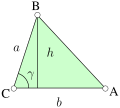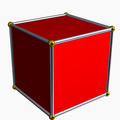Edge (geometry)
-
A polygon is bounded by edges; thissquarehas 4 edges.
-
Every edge is shared by three or more faces in a 4-polytope, as seen in this projection of a tesseract.
In geometry, an edge is a particular type of line segment joining two vertices in a polygon, polyhedron, or higher-dimensional polytope.[1] In a polygon, an edge is a line segment on the boundary,[2] and is often called a polygon side. In a polyhedron or more generally a polytope, an edge is a line segment where two faces (or polyhedron sides) meet.[3] A segment joining two vertices while passing through the interior or exterior is not an edge but instead is called a diagonal.
Relation to edges in graphs
In
Number of edges in a polyhedron
Any
where V is the number of
Incidences with other faces
In a polygon, two edges meet at each vertex; more generally, by Balinski's theorem, at least d edges meet at every vertex of a d-dimensional convex polytope.[6] Similarly, in a polyhedron, exactly two two-dimensional faces meet at every edge,[7] while in higher dimensional polytopes three or more two-dimensional faces meet at every edge.
Alternative terminology
In the theory of high-dimensional
See also
References
- ISBN 9780387943657.
- ^ Weisstein, Eric W. "Polygon Edge". From Wolfram MathWorld.
- ^ Weisstein, Eric W. "Polytope Edge". From Wolfram MathWorld.
- ISBN 9780387927145.
- .
- MR 0126765.
- ISBN 9780521098595.
- S2CID 8342016.





